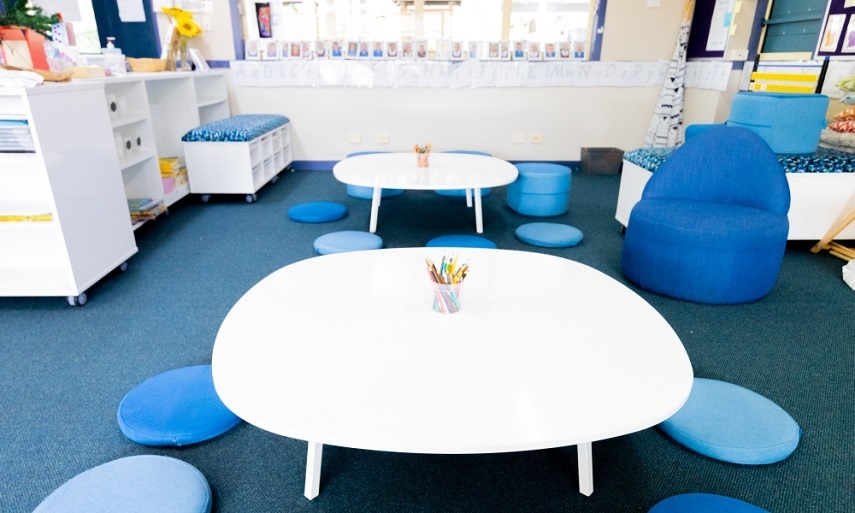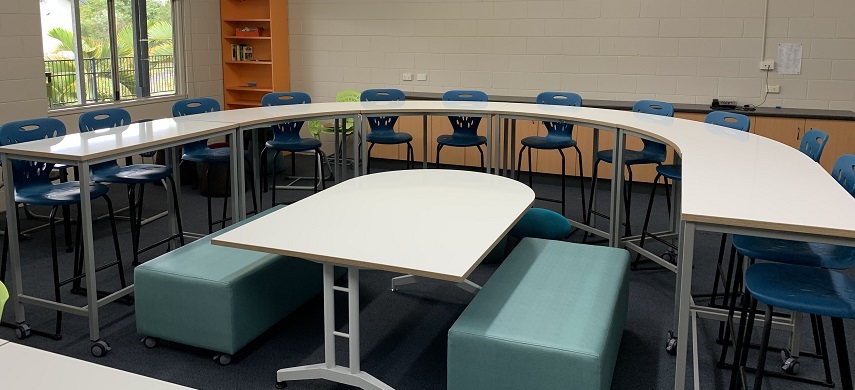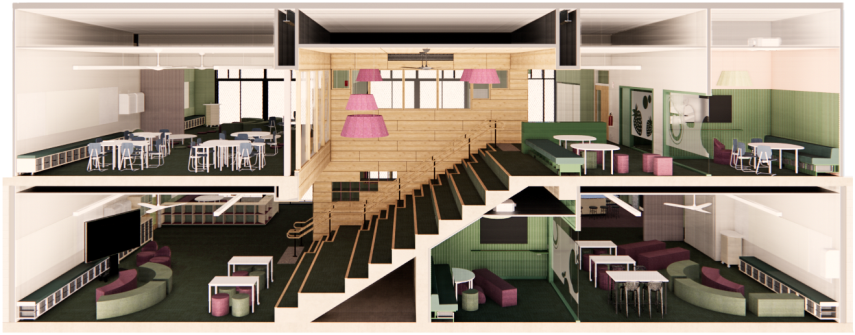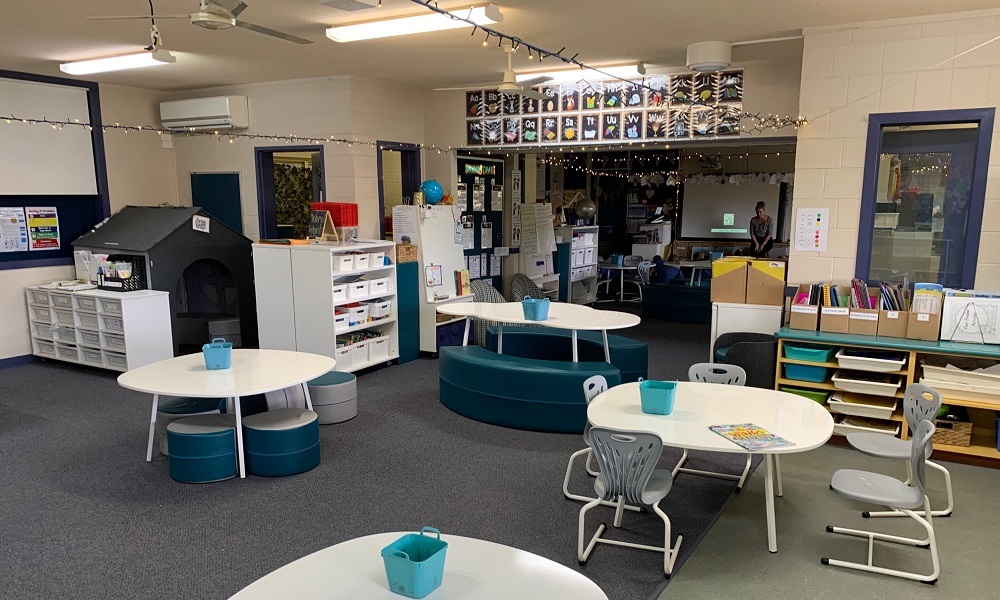‘We all have different strengths and we bring different perspectives, knowledge and skills, which really are necessary to achieve all the goals that we’re aiming for – of excellence in the classroom and a richness of practice.’
Greg Mattiske has been an educator at Suncoast Christian College for 25 years, the last five of those as principal. It’s this role that has allowed him to lead a major shift to open up classrooms, encourage greater sharing of practice, and bring a range of staff together to plan, teach and assess collaboratively.
As the name suggests the school is on Queensland’s Sunshine Coast, in the town of Wombye, roughly 100 kilometres north of Brisbane. The P-12 independent school was founded in 1979 by Nambour Christian Outreach Centre (now Suncoast Church) on a 23-acre pineapple farm. The 40-year-old campus is home to 880 students and just over 170 staff, including 79 teaching staff. There’s also an early learning centre on site.
Explaining the decision to make the move to team teaching, Mattiske says in his view it would be an ‘insanity’ for people to work in a classroom next to each other and not collaborate. He adds the challenge of meeting the needs of each student is a priority for the school, but it’s not always possible for one person, in an isolated classroom, to deliver it all.
‘We had been a school where teachers were very siloed,’ Mattiske recalls. ‘When another teacher or a visitor entered the classroom all activity would stop … the teachers were quite protective of their environment.
‘We’ve worked hard to open up our classrooms and for people to be open to having their practice observed, but also to share and move to more collaborative models – certainly in planning, where opportunities exist for team teaching.’
Learning from other schools
In addition to carrying out their own school-based research and a literature review, an important part of the journey has been learning from others, including visiting other schools and attending conferences. And it’s not just classroom practice that’s been the focus – to that end, this first phase has seen changes to existing learning environments and the second phase will see a new building with purpose-built spaces open in 2023.
Mattiske says an initial question he posed was: Within the bones that we’ve got, what can we do to enhance learning and enhance collaboration for people? ‘We wanted to have a step where we could change furniture and perhaps open up some classrooms in primary, but then thinking about the possibility of building and what that would look like.’
After attending several learning environment conferences he quickly discovered there were lots of ways to approach things. ‘We were interested in the teacher collaboration side of things, and meeting the needs of our team is the best way that we can truly meet the needs of students, and also achieve consistency of excellence. There were so many wonderful things shared at the conferences and, from there, I also got a list of places I wanted to go.’
In 2018, Mattiske took the whole executive team to Sydney for a study tour. The visit to Pacific Hills Christian School gave them lots of ideas they could already implement around furniture. From there they went to Claremont College, where the staff talked them through their journey so far – drawing on research literature and the results of their own action research. ‘We were just very much inspired by what they were achieving, as a 139-year-old school on a relatively small site at Coogee but with remarkable and imaginative learning spaces and true team teaching. Everything was team-based, delivering curriculum to a whole year level of students but not en masse – lots of attention to detail in small groups.’
They were bowled over by the approach and facilities at Northern Beaches Christian School. ‘We’ve got two staff at Suncoast who have worked at Northern Beaches and have been on their journey so we’ve got the tremendous benefit of hearing about the pitfalls, but all the wonderful gains that were made – particularly in primary school and middle years. They undertook that revolution to move from the siloed traditional classroom to learning environments that truly unleashed wonderfully powerful pedagogies of learning but also the ways that the teachers had to change and progress. So that was very informative.’
Mattiske also took the opportunity to observe staff at a newly-built school while visiting friends in Finland. ‘Again, that was very inspirational, the journey they had been on. Interesting that the things that you see in Sydney and the ideas that people presented at conferences in Australia, there they are in Finland.’ And a study tour to Singapore was another chance to see team teaching in action.
From their research, the Suncoast executive concluded that team teaching would deliver the best social, emotional and academic outcomes for students. ‘We were really interested in the schools that had gone down the flexible learning furniture, classrooms and environments and team teaching – they were really achieving some wonderful gains, in terms of student resilience and independence. And so those things become very core to what we are aiming for here for our students as well.’
Changing pedagogies and learning spaces
The current campus has allowed for some spaces to be opened up to allow the whole of Year 3 or Year 4 teaching to be delivered in the same room, but there is also teaching across rooms and collaborating planning. ‘We’ve worked from Prep to Year 12 to have all of our year levels teaching and assessing the same kind of things at the same time – so the whole of Year 7, for example, would have the same assessment and we would backward map,’ Director of Teaching and Learning Haley Whitfield explains.
‘We’re not lock-step because we don’t want to lose our authenticity and just the beauty of what teachers bring individually to a classroom, but we’ve been trying to encourage collaborative practice where we bring the best of all of our ideas together for units. So, in a sense when teachers are in that room, what they are delivering has been created together and different teachers take the lead depending on where they feel more confident.
‘Moving to flexible learning spaces and collaborative teaching spaces has meant that we can differentiate not just in terms of ability but also pedagogy for learning. So, you can have multiple activities running simultaneously with a larger number of staff across extension but also filling gaps.’
Setting aside ample time for planning and collaboration has been key. There has also been a heavy investment in professional development and planning time for Teacher Aides (TAs) as true co-collaborators. ‘We’ll get them in for as much planning as we can so that they understand what the process of learning is and they are key to the design of the learning in some group contexts,’ Mattiske says. The planning sets out not just what is going to be delivered, but who the lead teacher will be. Everyone is in the room, or across the shared spaces, engaged in the activities.

[Changes to furniture have included making all surfaces writable. Image: supplied]

[And, the stand-up benches have proved to be a popular addition. Image: supplied]
Furniture has been refreshed across the whole school to allow more flexibility for students and teachers. Simple changes such as stand-up benches have proved popular with some learners, and all surfaces are now writable – and not just in the primary years. ‘Our seniors have loved it too,’ Mattiske (who teaches as Year 11 English class) says.
‘We’ve got a lot of laptops of course, but it’s really great to see students opting to do their thinking visibly using mind mapping or diagrams and even just writing it down, then they’ll whip out their phone and take a photo of it and they’ve captured their learning. Some of those things, students are demonstrating their own agency in their own learning there, I don’t have to tell them to do that.’
Preparing for a move to new surroundings
The school has been working with designers at m3architecture and will move into a new building for Years 1-6 in 2023. Three cohorts – Junior, Middle and Upper Primary – will each be taught by a team of six teachers and TAs, supported by curriculum and learning support specialists. Each cohort will have an open-plan space over two levels, including a kitchen, maker space, and areas for different sizes of student groupings.


[A sectional view of learning spaces in the new primary building. Image: m3architecture]
Stage leaders will manage the logistics and flow of people and spaces, holding a morning meeting to quickly map out the design of the day. Mattiske says this first phase has allowed staff to work through some of the challenges to be better prepared for the move. ‘We still will have many things to learn once we get in there but we’ll be well on our way, be thinking through some of the implications, opportunities and challenges for teaching and learning at Suncoast.’
Whitfield says the key is to keep listening to feedback – from teachers, TAs, support staff and students – to make sure the things that are working continue and where there are challenges they are addressed as a team. The days of everything coming to a standstill when another teacher or visitor enters the room have gone. ‘It’s so beautiful when you go in there, you can have five or six groups going and the kids now are so used to it they’re highly engaged,’ Whitfield shares. ‘You go in there and it’s just this exciting buzz of learning energy and kids are really empowered because they’re at ability, as opposed to sitting and just being I guess locked out from the learning, or bored just waiting for something.
‘But that takes a lot of time to plan. As the teams become more confident, they start to build a bigger toolkit of activities and collaborative strategies. So we’re seeing more groups, more activities, more engagement, and more student growth.’
For the last three years, the leadership team has been tracking the range of pedagogy used. ‘We do walk-throughs – our whole staff walks through and we gather data on a whole range of things. We’ve noticed that the range of pedagogy has changed. Four years ago direct instruction was our most commonly observed pedagogy and we see that that’s just part of a whole suite now.
‘We have about 15 different pedagogies that kind of balance out, which is amazing watching teachers catch a fire with different ways of engaging learners. And we haven’t lost core things – 96 per cent of our students can articulate the learning goal and 93 per cent have a rationale for why they’re learning in those spaces; so we haven’t lost those fundamental things of what are we doing and why?’
As a school leader, how do you make the best use of the expertise, knowledge and skills of staff members – including support staff? What opportunities exist for collaboration and sharing of practice?
Haley Whitfield says feedback from teachers, TAs, support staff and students is crucial so any challenges can be addressed as a team. How often do you seek feedback from staff and students on what’s working and what needs to be improved? Does this feedback influence your decisions and practice?



